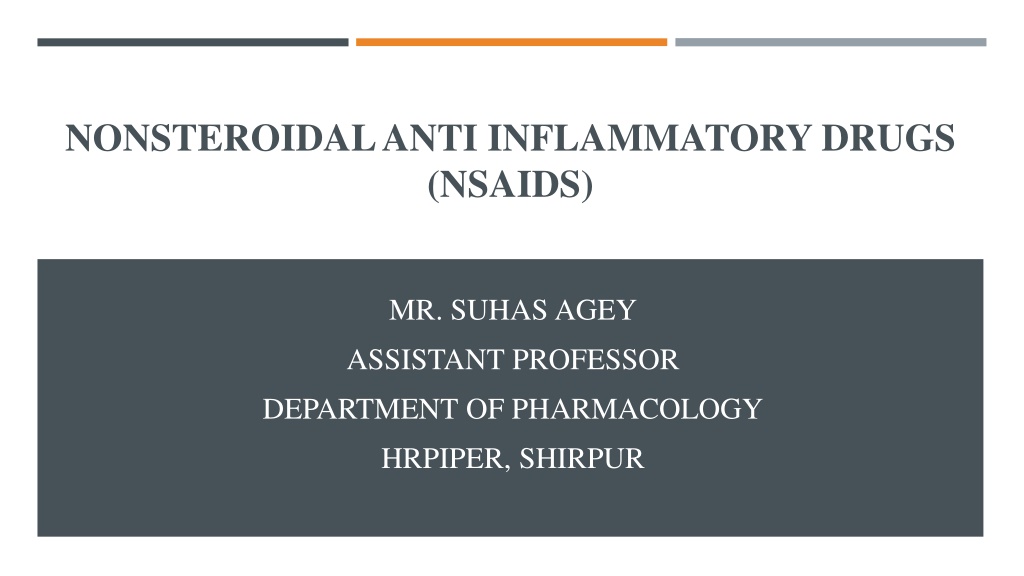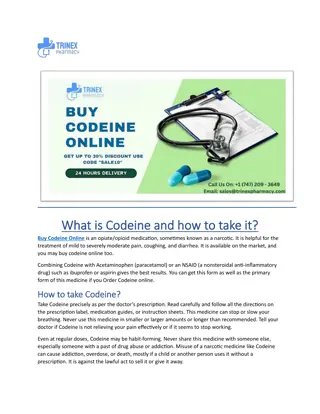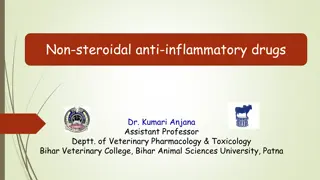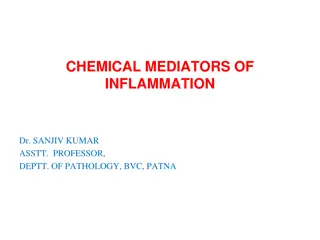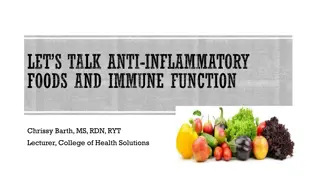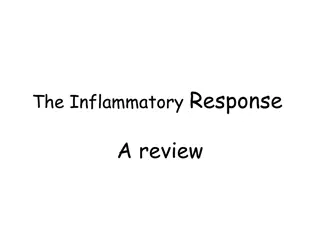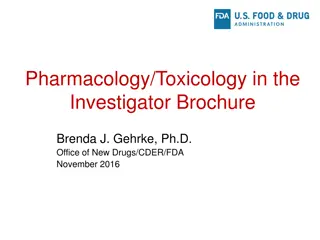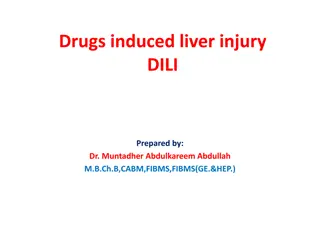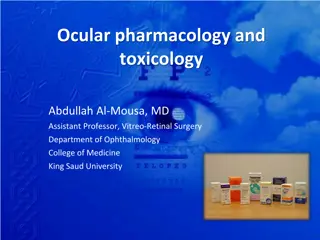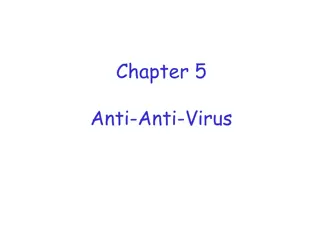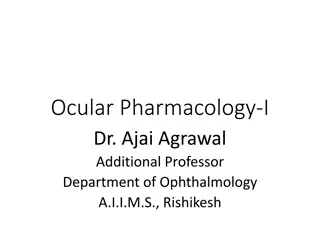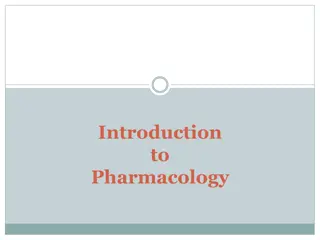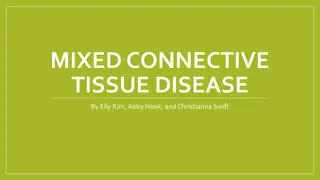Understanding Nonsteroidal Anti-Inflammatory Drugs (NSAIDs) and Their Pharmacology
Nonsteroidal anti-inflammatory drugs (NSAIDs) are a class of analgesic, antipyretic, and anti-inflammatory medications that work by inhibiting prostaglandin synthesis. They provide relief from pain, reduce fever, and combat inflammation through various mechanisms. Aspirin, a commonly used NSAID, irreversibly inhibits cyclooxygenase enzymes. NSAIDs play a crucial role in managing inflammatory pain without causing physical dependence or CNS depression.
Download Presentation

Please find below an Image/Link to download the presentation.
The content on the website is provided AS IS for your information and personal use only. It may not be sold, licensed, or shared on other websites without obtaining consent from the author. Download presentation by click this link. If you encounter any issues during the download, it is possible that the publisher has removed the file from their server.
E N D
Presentation Transcript
NONSTEROIDAL ANTI INFLAMMATORY DRUGS (NSAIDS) MR. SUHAS AGEY ASSISTANT PROFESSOR DEPARTMENT OF PHARMACOLOGY HRPIPER, SHIRPUR
CONTENTS 1. Introduction 2. Classification 3. NSAIDs Mechanism 4. Actions of NSAIDs 5. Pharmacology of Aspirin
The nonsteroidal anti inflammatory drugs (NSAIDs) and antipyretic analgesics are a class of drugs that have analgesic, antipyretic and anti inflammatory actions. The term "nonsteroidal" is used to distinguish these drugs from steroids, which have a similar eicosanoid-depressing, anti- inflammatory action. NSAIDs are non-narcotic, non-opioid, morphine they do not depress CNS, do not produce physical dependence, have no abuse liability and are particularly effective in inflammatory pain. aspirin-like analgesics. Unlike
NSAIDS AND PROSTAGLANDIN (PG) SYNTHESIS INHIBITION NSAIDs blocked prostaglandin (PG) generation. Prostaglandins, prostacyclin (PGI2) and thromboxane A, (TXA2 ) are produced from arachidonic acid by the enzyme cyclooxygenase. COX exists in a constitutive (COX-I) and an inducible (COX-2) isoforms; COX-1 serves physiological ' house keeping' functions, while the latter is induced by cytokines and other signal molecules at the site of inflammation. This leads to generation of PGs. Most NSAIDs inhibit COX-I and COX-2 non-selectively, but some selective COX-2 inhibitors have been available. Aspirin covalently binds COX-1 and COX-2, irreversibly inhibiting COX activity. Other NSAIDs are competitive and reversible inhibitors of COX.
ACTIONS Analgesia NSAIDs block the pain sensitizing mechanism induced by bradykinin, TNFa, interleukins (ILs) and other pain inducing substances primarily by inhibiting COX-2. Antipyresis NSAIDs lower body temperature in fever, but do not cause hypothermia in normal individuals. Fever during infection and tissue injury is produced through the generation of pyrogens including, ILs, TNF ., interferons which induce PGE2 production in hypothalamus-raise its temperature set point. NSAIDs block the action of these pyrogens. Anti-inflammatory The most important mechanism of anti-inflammatory action of SAIDs is considered to be inhibition of COX-2 mediated enhanced PG synthesis at the site of injury
ASPIRIN (SALICYLATES) Aspirin is acetylsalicylic acid. It is rapidly converted in the body to salicylic acid It is one of the oldest analgesic-anti- inflammatory drugs Mechanism- Irreversibly binds and inhibits both cyclo- oxygenase (COX-1 and COX-2). .(Refer flow chart)
PHARMACOLOGICAL ACTIONS 1.Analgesic, antipyretic, anti-inflammatory actions Aspirin is a weaker analgesic than morphine, However, it effectively relieves inflammatory pain, tissue injury related pain and integumental pain, but is relatively ineffective in severe visceral and ischemic pain. The analgesic action is mainly due to obtunding of peripheral pain receptors and prevention o f PG-mediated sensitization of nerve endings. Anti-inflammatory action is exerted at high doses. Signs of inflammation like pain, tenderness, swelling, vasodilatation and leucocyte infiltration are suppressed.
2 . GIT Salicylic acid released from aspirin irritate gastric mucosa, cause epigastric distress, nausea and vomiting.At high doses, it stimulates CTZ. Aspirin remains unionized and diffusible in the acid gastric juice, but on entering the mucosal cell, it ionizes and becomes in diffusible. This 'ion trapping in the gastric mucosal cell enhances gastric toxicity. This causes focal necrosis of mucosal cells and capillaries- acute ulcers, erosive gastritis, congestion and microscopic hemorrhages. 3. Blood Aspirin, even in small doses, irreversibly inhibits TXA2 synthesis by platelets. Thus, it interferes with platelet aggregation and bleeding time is prolonged to nearly twice the normal value. Long-term intake of large dose decreases synthesis of clotting factors in liver and predisposes to bleeding.
4. other effects of high (anti-inflammatory toxic) doses Cellular metabolism is enhanced, especially in skeletal muscles, Glucose utilization is increased resulting in fall in blood glucose level (especially in diabetics); liver glycogen is depleted. Respiration is stimulated by direct action on respiratory center as well as due lo increased CO2 production. Aspirin has no direct effect on heart or circulation, but doses which enhance metabolic rate, increase cardiac output indirectly. Aspirin interferes with urate excretion and antagonizes the uricosuric effect of probenecid.
PHARMACOKINETICS Oral Administration Absorb in stomach and small intestine 80% plasma protein bound Rapidly deacetylated in GI wall and liver Eliminated from urine
ADVERSE EFFECTS Gastrointestinal disturbances, especially gastric bleeding. In high dosage can cause salicylism (tinnitus, vertigo, allergic reactions occasionally; renal toxicity rarely. Can cause the potentially fatal Reye s syndrome (encephalopathy disorder) in children infection. At therapeutic dose hyperuricemia. Prolongs bleeding time. reduced hearing); & liver viral after a it can cause
T. USES As analgesic- For headache (including mild migraine), backache, myalgia, joint pain, pulled muscle, toothache, neuralgias and dysmenorrhoea 1. As antipyretic- Aspirin is effective in fever of any origin; dose is same as for analgesia. However, paracetamol, being safer, is generally preferred. 2. Acute rheumatic fever- Aspirin is the first choice drug; other drugs are added only when it fails or in severe cases ( corticosteroids act faster). 3. Rheumatoid arthritis- Aspirin in a dose of 3- 5 g/day produces relief of pain, swelling and morning stiffness; newer NSAlDs are preferred now 4. Osteoarthritis- It affords symptomatic relief; paracetamol is the first choice analgesic for OA. 5. Post myocardial infarction and poststroke patients- By inhibiting platelet aggregation aspirin lowers the incidence of re-infarction. 6. Prevention of preeclampsia- Aspirin 80- 100 mg/day administered from 12th week of gestation till child birth has been found to reduce the risk of preeclampsia. 7.
PARA-AMINO PHENOL DERIVATIVES Paracetamol (acetaminophen) It is the de-ethylated active metabolite of phenacetin that was also introduced in the last century, but has come into common use only since 1950. Actions The central analgesic action of paracetamol is like aspirin, i.e. it raises pain threshold. but has weak peripheral anti-inflammatory component. Analgesic action of aspirin and paracetamol is additive. Paracetamol is a good and promptly acting antipyretic. Paracetamol has negligible anti-inflammatory action. It is a poor inhibitor of PG synthesis in peripheral tissues, but more active on COX in the brain. It is not able to inhibit COX in the presence of peroxides which are generated at sites of inflammation. he ability of paracetamol to inhibit COX-3 (an isoenzyme so far located in dog brain) could also account for its analgesic-antipyretic action.
ADVANTAGES OF PARACETAMOL OVER ASPIRIN In contrast to aspirin, paracetamol does not stimulate respiration or affect acid-base balance; does not increase cellular metabolism. It has no effect on CVS. Gastric irritation is insignificant- mucosal erosion and bleeding occur rarely only in overdose. It does not affect platelet function or clotting factors and It is not uricosuric.
PHARMACOKINETICS Well absorbed orally, Only about 1/4th is protein bound in plasma and is uniformly distributed in the body. Metabolism occurs mainly by conjugation with glucuronic acid and sulfate: conjugates are excreted rapidly in urine. Plasma t is 2- 3 hours. Effects after an oral dose last for 3- 5 hours.
ADVERSE EFFECTS In isolated antipyretic doses paracetamol is safe and well tolerated. nausea and rashes occur occasionally Acute paracetamol poisoning- It occurs especially in small children who have low hepatic glucuronide conjugating ability. If a large dose (> 150 mg/kg or > 10 g in an adult) is taken, serious toxicity can occur. Fatality is common with > 250 mg/kg. Mechanism of toxicity N-acetyl-p-benzoquinoneimine (NABQI) is a highly reactive minor metabolite of paracetamol which is detoxified by conjugation with glutathione. When a very large dose of paracetamol is taken, glucuronidation capacity is saturated, metabolite is formed- hepatic glutathione is depleted and this metabolite binds covalently to proteins in liver cells (and renal tubules) causing necrosis.
Treatment for poisoning If the patient is brought early, vomiting should be induced or gastric lavage done. Activated charcoal is given orally Specific antidote: N-acetylcysteine- 150 mg/kg should be infused i. v. in 200 ml 5% glucose solution over 15 min, followed by the same dose given i. v. over the next 20 hours.
USES Paracetamol is one of the most commonly used 'over-the-counter analgesics for headache, mild migraine, musculoskeletal pain, dysmenorrhoea, etc. Paracetamol is recommended as first choice analgesic for osteoarthritis by many professional bodies. lt is one of the best drugs to be used as antipyretic for fever due to any cause, especially in children (no risk of Reye s syndrome).
